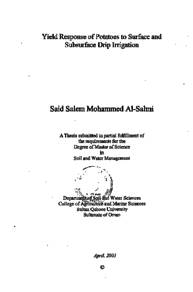Document
Yield response of potatoes to surface and subsurface drip irrigation
Publisher
Sultan Qaboos University
Gregorian
2003
Language
English
English abstract
Irrigation in Oman is an ancient practice whereas groundwater is the main SON source for irrigation. Aflaj and wells have been used over the years to irrigate plantations. Expansions in irrigated areas and population growth have led to groundwater depletion, lowering of water tables and seawater intrusion in coastal areas. Modern irrigation systems were introduced as part of an integrated effort to conserve water resources. The effects of drip irrigation on potato yields were investigated in this study. One or two plants per emitter have been irrigated through surface and subsurface water applications of two amounts of water (4 - 8 mm / day). Throughout the experiments, soil salinity change with time was monitored directly on the site at two depths (1 - 10 cm) in all treatments using a special Sigma Probe instrument. Soil moisture contents were measured by using tensiometers throughout the growing season Good yields were harvested from all the treatments with the presence of significant differences in the total weight, tuber numbers and average weight due to planting numbers per emitter, amount of water application rates and surface or subsurface irrigation methods. Salinity and moisture content showed some difference
between treatments. Contour lines were used to illustrate the change of salinity through the soil profile due to the difference in irrigation methods. It was concluded that subsurface drip irrigation system was the best method to produce higher potato yields and higher water use efficiency. More yields were obtained as more potato tuber numbers planted and more water application rates were applied. Low amount of salts were formed on the soil surface with surface drip irrigation.
Member of
Resource URL
Arabic abstract
اعتمدت الزراعة في عمان على المياه الجوفية منذ القدم وذلك باستخدام الطرق التقليدية للري كالافلاج والآبار. زيادة عدد السكان والأراضي المزروعة أدى إلى ازدياد الاعتماد على المياه الجوفية واستنزافها و نقصها وتأثرها بالمياه المالحة وخصوصا في المناطق الساحلية فظهرت الحاجة إلى استخدام أنظمة الري الحديثة لتوفير المياه المستخدمة بالزراعة من بين الحلول الأخرى المتاحة. إن الهدف من هذه التجربة هو دراسة تأثير نظام الري بالتنقيط على إنتاجية محصول البطاطس وذلك باستخدامه على سطح التربة أو على عمق ۱۰ سم تحت سطح التربة. تم إضافة كميات مختلفة من المياه ( 4 و 8 مم - اليوم ) وزراعة درنة أو درنتان من البطاطس لكل قطارة. تمت مراقبة تغيير رطوبة وتملح التربة على أعماق مختلفة باستخدام أجهزة متخصصة .
نتج من هذه المعاملات محصول جيد وكان الاختلاف واضحا من حيث الناتج الكلى وعدد الدرنات المحصودة ووزن الدرنة الواحدة. ولقد تم رسم حركة ملوحة التربة عن طريق خطوط الكنتور الهندسية . في نهاية التجربة وجد أن نظام الري بالتنقيط المغطى بالتربة قد انتج وزنا اكبر لكل درنة مع حصوله على كفاءة استخدام افضل بالمقارنة مع نظام الري بالتنقيط الممدود على السطح. كما لوحظ تكوين ملوحة اقل عند استخدام نظام الري السطحي وخصوصا في سطح التربة. ويمكن الاستنتاج بزيادة الإنتاجية الكلية البطاطس مع ازدياد كمية المياه المستخدمة وزيادة عدد الدرنات المزروعة لكل قطارة.
نتج من هذه المعاملات محصول جيد وكان الاختلاف واضحا من حيث الناتج الكلى وعدد الدرنات المحصودة ووزن الدرنة الواحدة. ولقد تم رسم حركة ملوحة التربة عن طريق خطوط الكنتور الهندسية . في نهاية التجربة وجد أن نظام الري بالتنقيط المغطى بالتربة قد انتج وزنا اكبر لكل درنة مع حصوله على كفاءة استخدام افضل بالمقارنة مع نظام الري بالتنقيط الممدود على السطح. كما لوحظ تكوين ملوحة اقل عند استخدام نظام الري السطحي وخصوصا في سطح التربة. ويمكن الاستنتاج بزيادة الإنتاجية الكلية البطاطس مع ازدياد كمية المياه المستخدمة وزيادة عدد الدرنات المزروعة لكل قطارة.
Category
Theses and Dissertations

